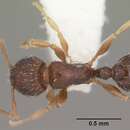en
names in breadcrumbs


(Fig. 29)
Holotype worker. TL 21, HL 0.52, HW 0.45, CI 87, SL 0.36, SI 80, PW 0.33, AL 0.58.
Mandibles unsculptured except for scattered small pits; anterior clypeal margin entire. Frontal carinae feeble, beyond the level of the midlength of the eye not more strongly developed than the cephalic iugular sculpture, merely narrow, slightly raised continuous lines which fade out before reaching the occiput. Antennal scrobes vestigial. Eyes moderately developed, with 6 - 7 ommatidia across the greatest diameter. With the head in full-face view the sides behind the eyes weakly convex, rounding into the occipital margin which is very feebly concave medially. Sides of head behind eyes without projecting hairs although some faint, very short pubescence may be present. Propodeum armed with a pair of minute triangular denticles which are much shorter than the broad, triangular metapleural lobes. Node of petiole in profile characteristically shaped, quite long and low, with rounded angles and tapering from a broader base to a narrower apex, both anterior and posterior faces sloping inwards. In dorsal view the node is about as long as broad. Dorsum of head with widely spaced, very fine longitudinal rugulae, the spaces between them shining and with only faint superficial reticulation. Dorsal alitrunk similarly but less regularly and more weakly sculptured, with a tendency for the rugulae to break or fade out. Pedicel segments feebly sculptured, the gaster smooth. All dorsal surfaces of head and body with numerous short, stout, blunt hairs; the appendages with fine appressed pubescence. Colour dark blackish brown, the appendages somewhat lighter.
Paratype workers. As holotype, measuring TL 2.0 - 2.2, HL 0.52 - 0.56, HW 0.44 - 0.48, CI 84 - 87, SL 0.35 - 0.40, SI 80 - 85, PW 0.32 - 0.35, AL 0.55 - 0.62 (12 measured). Some paratypes lighter brown than the holotype.
Holotype worker, Madagascar: Bekonazy to 5 km S, forest w. baobabs (N. of Morondava), 27. iii. 1969, dry forest (W. L. Brown) (written beneath the lower data label is ' pile of baobob chips') (MCZ, Cambridge). Paratypes. 14 workers with same data as holotype (MCZ, Cambridge; BMNH).
Diagnostic features of this small species include the shape of the petiole node and the unsculptured mandibles. It occurs quite commonly on Aldabra as indicated by 5 short series collected by V. Spaull in 1974 - 75 (BMNH) and a series collected by Cogan and Hutson in the same islands. These specimens resemble the type-series closely, the shape of the petiole being the same, but in a few faint traces of sculpture are present on the mandibles, there is a tendency for the alitrunk to be more strongly sculptured, and the colouring tends to be lighter brown than in the Malagasy material, although some are quite as dark brown as the types. The size range of the Aldabra material overlaps the range given for the paratypes, with some workers being slightly larger: HL 0.52 - 0.60, HW 0.44 - 0.52, CI 84 - 87, SL 0.36 - 0.42, SI 80 - 85, PW 0.32 - 0.36, AL 0.55 - 0.64 (12 measured).